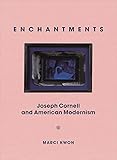Enchantments : Joseph Cornell and American Modernism / Marci Kwon.
Material type: TextPublisher: Princeton, NJ : Princeton University Press, [2021]Copyright date: ©2021Description: 1 online resource (272 p.) : 121 color + 82 b/w illusContent type:
TextPublisher: Princeton, NJ : Princeton University Press, [2021]Copyright date: ©2021Description: 1 online resource (272 p.) : 121 color + 82 b/w illusContent type: - 9780691215020
- Modernism (Art) -- United States
- ART / History / Modern (late 19th Century to 1945)
- A Parrot for Juan Gris
- Aaron Siskind
- Alfred Barr
- Cassiopeia 1
- Charles Henri Ford
- Christian Science
- Cockatoo
- Come Live with Me
- Dance Index
- Donald Windham
- Enchanted Wanderer
- George Balanchine
- Habitat Group for a Shooting Gallery
- Jackson Pollock
- Marcel Duchamp
- Marianne Moore
- Mary Baker Eddy
- MoMA
- Pavel Tchelitchew
- Robert Rauschenberg
- Soap Bubble Set
- Stan Brakhage
- Swan Lake for Tamara Toumanova
- Taglioni’s Jewel Casket
- Tilly Losch
- Toward the Blue Peninsula
- Willem de Kooning
- assemblage
- bricolage
- 709.2 23
- N6537.C66 K89 2021
- N6537.C66 K89 2021
- online - DeGruyter
| Item type | Current library | Call number | URL | Status | Notes | Barcode | |
|---|---|---|---|---|---|---|---|
 eBook
eBook
|
Biblioteca "Angelicum" Pont. Univ. S.Tommaso d'Aquino Nuvola online | online - DeGruyter (Browse shelf(Opens below)) | Online access | Not for loan (Accesso limitato) | Accesso per gli utenti autorizzati / Access for authorized users | (dgr)9780691215020 |
Frontmatter -- CONTENTS -- PREFACE The Great and the Small -- ACKNOWLEDGMENTS -- Enchantments -- Parts of a World -- Universe to Cosmos -- Folk into Myth -- Enchantresses -- Rooms and Skies -- Some Varieties of Enchantment -- NOTES -- INDEX -- CREDITS
restricted access online access with authorization star
http://purl.org/coar/access_right/c_16ec
The first major work to examine Joseph Cornell's relationship to American modernismJoseph Cornell (1903–1972) is best known for his exquisite and alluring box constructions, in which he transformed found objects—such as celestial charts, glass ice cubes, and feathers—into enchanted worlds that blur the boundaries between fantasy and the commonplace. Situating Cornell within the broader artistic, cultural, and political debates of midcentury America, this innovative and interdisciplinary account reveals enchantment's relevance to the history of American modernism.In this beautifully illustrated book, Marci Kwon explores Cornell's attempts to convey enchantment—an ephemeral experience that exceeds rational explanation—in material form. Examining his box constructions, graphic design projects, and cinematic experiments, she shows how he turned to formal strategies drawn from movements like Transcendentalism and Romanticism to figure the immaterial. Kwon provides new perspectives on Cornell's artistic and graphic design career, bringing vividly to life a wide circle of acquaintances that included artists, poets, writers, and filmmakers such as Mina Loy, Lincoln Kirstein, Frank O’Hara, and Stan Brakhage. Cornell's participation in these varied milieus elucidate enchantment's centrality to midcentury conversations about art's potential for power and moral authority, and reveals how enchantment and modernity came to be understood as opposing forces. Leading contemporary artists such as Betye Saar and Carolee Schneemann turned to Cornell's enchantment as a resource for their own anti-racist, feminist projects.Spanning four decades of the artist's career, Enchantments sheds critical light on Cornell's engagement with many key episodes in American modernism, from Abstract Expressionism, 1930s "folk art," and the emergence of New York School poetry and experimental cinema to the transatlantic migration of Symbolism, Surrealism, and ballet.
Mode of access: Internet via World Wide Web.
In English.
Description based on online resource; title from PDF title page (publisher's Web site, viewed 01. Dez 2022)


